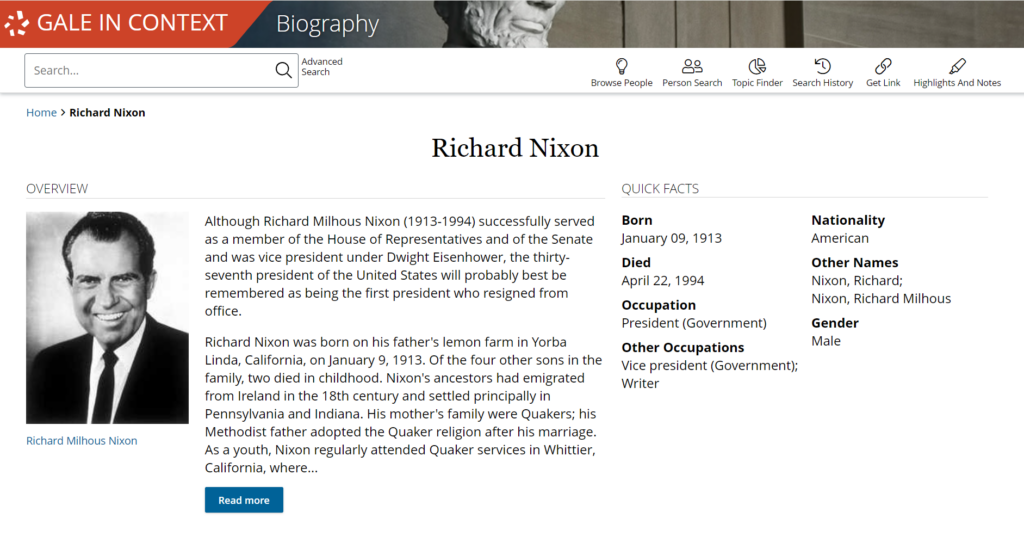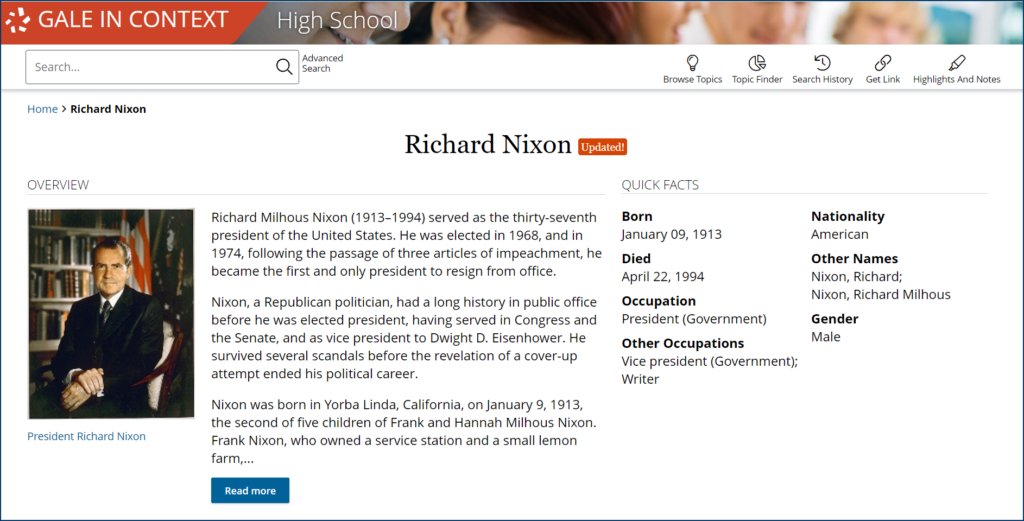| By Gale Staff |
Fifty years ago, on August 9, 1974, Richard Nixon resigned from presidential office. During his tenure, Nixon improved fractured international relationships and embarked on significant environmental initiatives. He was president during major milestones in American history, including the end of the Vietnam War and the first Moon landing. Nonetheless, the infamous Watergate scandal ultimately forced him to resign and overshadows his accomplishments to this day. Nixon remains the only president of the United States to resign from office.
For the 50th anniversary of such a tremendous historical moment, we encourage K-12 educators to revisit Nixon’s presidency. You and your students can use Gale collections to discover valuable resources related to Nixon’s domestic and foreign policy successes—alongside his dramatic fall from grace. With Gale, researchers can leverage the user-friendly platform and built-in recommendations for related resources across our themed databases. Content is diverse, vetted, and well-organized, ensuring that students can engage with the various perspectives on Nixon’s legacy in a productive way.
Begin with Biography
Biography empowers researchers to learn about and connect with the real people behind major world events and gain a glimpse into their humanity and struggles.
With the dedicated Nixon topic page in Gale In Context: Biography, students can do more than read about Nixon’s life. Debate footage, images of a young Nixon and his family, and transcripts of his famous speeches bring his political career to life. With Gale In Context: Biography, your students can look behind the scenes of Nixon’s storied life, from his troubled childhood and public service to his tumultuous abdication of office.
Journey with Richard Milhous Nixon from his upbringing on a lemon farm in California. His early years were marked by abuse and poverty, which likely fed into Nixon’s overwhelming drive to succeed at any cost—even if that meant breaking a few rules along the way. Despite identifying with his family’s humble Quaker faith, he was a combative adult, finding natural success as a lawyer, Naval lieutenant, and politician.
By his early thirties, in 1946, Nixon was elected to the U.S. House of Representatives. A dynamic debater and anti-communist champion, he caught the attention of the Republican Party and in 1952, he was VP on Eisenhower’s presidential ticket. After losing to John F. Kennedy, the Democratic Party’s rising star, in 1960, Nixon won the 1968 presidential contest against a beleaguered Democratic ticket.
Study Nixon’s Time in the White House
As vice president to Dwight Eisenhower, Nixon completely redefined the traditional back-seat VP role; instead, he was outspoken and actively engaged in foreign policy. As president, Nixon served as a peacemaker in heightened global conflicts. He helped forge a more positive relationship with China and initiated nuclear arms limitations with the Soviet Union. At home, he encouraged the federal government to fund cancer research, founded the Environmental Protection Agency, and expanded voter rights. Despite serving just five years in office, the impact of Nixon’s presidency is ongoing.
Using Gale In Context: High School, your high schoolers can further study Nixon’s time in the White House and learn more about his accomplishments as a world leader. In a single comprehensive database, students can access thousands of authoritative, age-appropriate, and curriculum-aligned resources.
Students can explore and search thousands of materials related to Nixon’s accomplishments through a dedicated—and recently updated—topic page. Direct them to the main summary page, which features helpful learning aids, including a timeline and built-in reflection questions. Using these resources encourages users to identify aspects of Nixon’s presidency that surprise them. What were some major accomplishments? How did Nixon’s administration shape the modern world?
Educators can trust Gale’s content as high schoolers develop the critical thinking and independent research abilities they will need for long-term academic success.
Address the Watergate Scandal
On June 17, 1972, a team employed by Nixon’s re-election campaign burglarized and set up illegal surveillance equipment at the Democratic National Committee’s headquarters at the Washington, D.C., complex of The Watergate Hotel. The individuals were caught and arrested, and the Nixon administration quickly began an extensive cover-up. While Nixon denied involvement, his opponents accused him of obstruction of justice. Those claims would ultimately lead to impeachment charges. With the evidence stacked against him, Nixon resigned as president.
His successor, Gerald Ford, promptly pardoned Nixon for the alleged federal crimes. Determined to salvage what he could of his presidential legacy, Nixon continued to deny his involvement and point fingers at those who gained politically from the Watergate accusations. However, following his death in 1994, evidence was made public that definitively proved Nixon’s involvement in the crimes and cover-up.
It’s impossible to discuss Nixon without touching on the Watergate scandal. With Gale In Context: U.S. History, you can dive into the compelling details and how the crime changed the country’s history. Encourage students to consider what his resignation suggests about Nixon’s complicated character. Despite his insatiable, lifelong need to succeed, he famously said during his resignation speech, “I must put the interests of America first.” It’s even said that he spent his last few hours as president crying in the Oval Office, devastated by his compromised legacy.
Reflect on Nixon’s involvement with Watergate in the context of his broader presidency. Do Nixon’s crimes parallel recent presidential scandals? How have the American public’s expectations of the president evolved over the past 50 years? Is the president ever above the law? As we approach its 50th anniversary, Nixon’s resignation provokes important questions relevant to today’s political landscape and highlights a truly compelling chapter in our country’s history.
Despite (or perhaps because of) all his triumphs and failings, Nixon was a fascinating leader. Gale databases can help K-12 educators create enriching lesson plans about him and countless other figures, major events, and topics.



